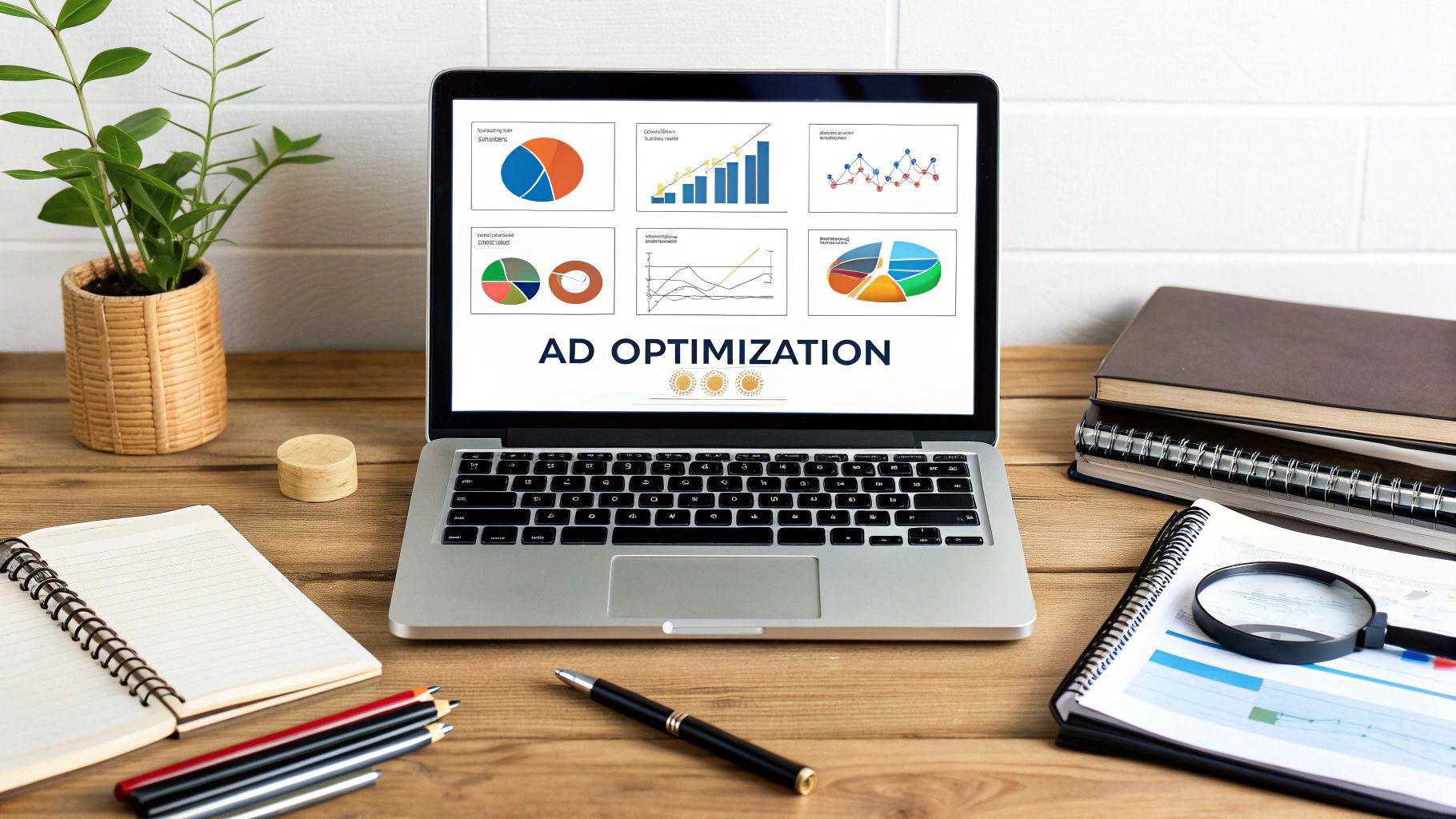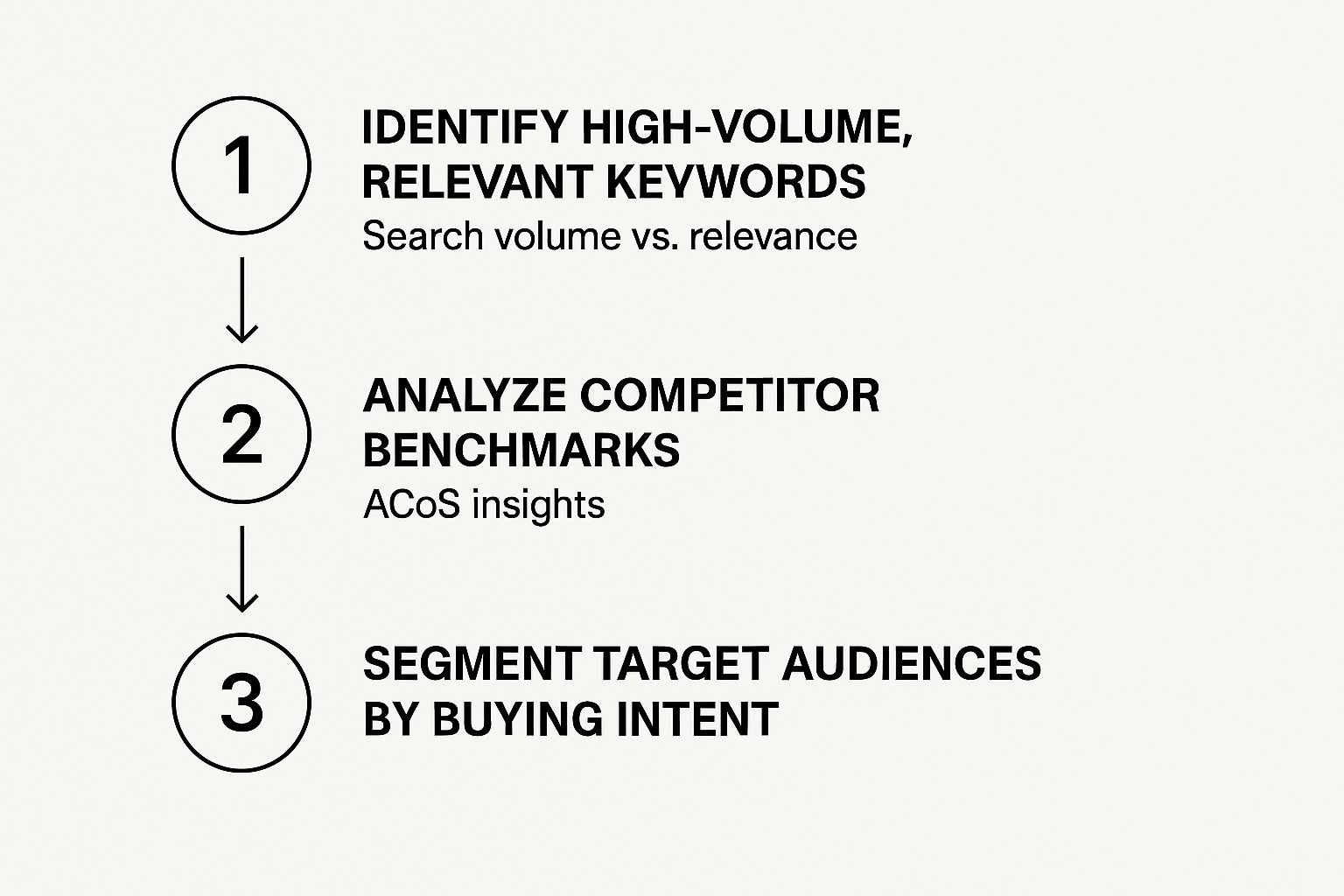A Guide to Amazon Advertising Optimization
Unlock profitable growth with our guide to Amazon advertising optimization. Learn data-driven strategies for PPC to boost visibility and maximize your ROAS.

Before you even think about tweaking bids or pouring over keyword reports, let's talk about the single most important thing you can do for your Amazon advertising optimization: building a clean, scalable campaign foundation.
I've seen it time and time again—a disorganized account is the fastest way to burn through your ad spend and completely miss out on growth. A solid structure, on the other hand, makes everything that comes after it—the analysis, the optimizations, the scaling—so much faster and more effective.
Build a Scalable Campaign Foundation
Winning at Amazon advertising doesn’t start with aggressive bidding; it begins with thoughtful organization. Think of it like building a house. You wouldn’t start hanging drywall before you’ve poured the foundation and have a solid blueprint. In the world of PPC, your campaign structure is that blueprint. It dictates how you manage budgets, analyze what’s working, and scale your efforts over the long haul.
When an account is a jumble of different products, match types, and random strategies, it quickly becomes a nightmare to manage. You can't tell what's working, where your money is actually going, or how to make things better. It’s a common pitfall that I’ve seen lead to a ton of frustration and wasted cash.
The Power Duo: Automatic and Manual Campaigns
The secret to a powerful campaign structure isn't complicated. It boils down to the strategic partnership between automatic and manual campaigns. These two work together in a constant feedback loop, helping you find new opportunities and then double down on what’s already proven to work.
Automatic Campaigns (The Explorers): Think of these as your recon team. You give Amazon your product, and its algorithm goes out to find relevant keywords and product pages to target based on your listing. Their main job is to "discover" high-converting customer search terms you might not have thought of yourself.
Manual Campaigns (The Snipers): These are for precision. Once you identify profitable search terms from your automatic campaigns, you move them over to manual campaigns. Here, you get granular control over the keyword match type (Broad, Phrase, Exact) and the specific bid for each term, letting you maximize the return on your top performers.
The best-structured accounts use automatic campaigns to feed a steady stream of data-backed keywords into manual campaigns. This creates a self-improving system where you’re always refining your targeting based on real customer behavior.
Organizing for Clarity and Control
To make this system truly hum, you need to get serious about segmentation. Grouping your campaigns logically is how you prevent budget overlap and make performance analysis a breeze. A really practical way to do this is by segmenting campaigns by product line, match type, and strategic goals.
For instance, if you sell a popular yoga mat in three different colors, don't just throw them all into one ad group. Create separate ad groups for "blue yoga mat," "pink yoga mat," and "green yoga mat." This lets you tailor your ads and bids based on which color performs best and makes sure a customer searching for a blue mat sees an ad for that exact product.
This level of detail is what gets you highly relevant traffic. Just look at how Sponsored Products show up directly in the shopping results—your ad needs to match the search query perfectly.

This image really drives home the point: your product is competing for attention right next to organic results. Hyper-relevance is non-negotiable if you want to earn that click, especially since most Amazon shoppers never leave the first page.
To help you visualize how different campaign types fit into this structure, here's a quick breakdown of the core options available on Amazon.
Core Amazon Advertising Campaign Types
| Campaign Type | Primary Goal | Best Used For |
|---|---|---|
| Sponsored Products | Drive Sales | Promoting individual product listings in search results and on product pages. |
| Sponsored Brands | Build Brand Awareness | Showcasing a collection of products and your brand logo at the top of search results. |
| Sponsored Display | Retargeting & Reach | Re-engaging shoppers off Amazon and targeting audiences on and off the platform. |
Each of these plays a unique role, but they all benefit from the organized, data-driven foundation we've been discussing.
The competition for this prime digital real estate is fierce and only getting more intense. Global Amazon advertising revenue, which hit $37.7 billion in 2022, is projected to skyrocket to $94 billion by 2026. This explosive growth is precisely why a disciplined approach to campaign structure and amazon advertising optimization is no longer just a good idea—it’s essential for any seller who wants to win. If you're interested in a deeper dive, you can explore more about these advertising trends and what they mean for your strategy.
Mastering Keyword Harvesting and Targeting
If your campaign structure is the foundation, then your keywords are the engine driving your Amazon advertising optimization. A winning keyword strategy isn't about guessing what your customers are searching for. It's about using hard data to find the exact phrases they type right before they hit "buy." This is where a powerful technique called keyword harvesting comes in.
Think of your broad match and automatic campaigns as your R&D department. They aren't just for getting clicks; they're discovery tools. They constantly unearth new, high-converting customer search terms you can then move into more controlled campaigns to really scale your results.
Turning Data into Profit
It all starts in your advertising console’s Search Term Report. This report is a goldmine, showing you the literal search queries shoppers used before clicking your ad. Your job is to sift through this raw data to find the gems—the terms that bring in sales at a healthy ACoS.
Let's say you sell "eco-friendly bamboo toothbrushes." An automatic campaign might reveal that while you bid on broad terms, a very specific query like "soft bristle bamboo toothbrush multipack" has a fantastic conversion rate. You probably wouldn't have thought to target that long-tail keyword on your own.
Your Search Term Report is a direct line to your customer's brain. It tells you what they actually search for, not what you think they search for. This insight is the key to precise, profitable targeting.
Once you spot these winners, the next move is critical. You migrate them over to your manual campaigns, but not just anywhere. These harvested keywords should be added as exact match keywords. This gives you surgical control, letting you set a specific, aggressive bid on a term you already know converts well.
This simple workflow shows you how to systematically find, analyze, and segment keywords for much better performance.

This flow isn't a one-time task; it's a powerful loop where your campaigns constantly learn and get smarter based on real shopper data.
Creating a Self-Improving Loop
To make this strategy truly work, you have to close the loop. After moving a high-performing search term like "soft bristle bamboo toothbrush multipack" into a manual campaign as an exact match, you need to go back to the original discovery campaign.
In that auto or broad match campaign, you add that same phrase as a negative exact match. This is a non-negotiable step. It stops your discovery campaigns from continuing to spend money on a term you're now targeting precisely elsewhere. It prevents budget cannibalization, where your own campaigns compete against each other. This ensures your ad spend is funneled efficiently, with your "sniper" manual campaign handling the proven winners.
This creates a self-improving system where your campaigns get smarter over time.
- Discovery Campaigns (Auto/Broad): Their main job is to constantly find new, profitable customer search terms.
- Performance Campaigns (Manual/Exact): These are built to capitalize on proven terms with precise, controlled bidding.
- Negative Keywords: They stop wasted spend and force your budget toward your most effective targets.
This process is a cornerstone of successful Amazon advertising. Many experts call this optimization approach “match-type mirroring,” where automatic campaigns discover what works, and manual campaigns exploit it. To discover more insights about this optimization approach, you can see how it balances the low CPCs of auto campaigns with the surgical control of manuals.
Beyond Keywords to ASINs
This harvesting concept isn't just for keywords. Your automatic campaigns also target competitor and complementary product detail pages, identified by their ASINs. The exact same logic applies.
Dig into your search term report and filter it to show only ASINs. If you find your ads are consistently converting when they appear on a specific competitor's product page, that's a huge signal. Harvest that high-performing ASIN and add it to a manual product targeting (PAT) campaign. Now you can bid specifically to show up on that page and steal sales directly from your competition.
By systematically harvesting both keywords and ASINs, you shift from a reactive to a proactive advertising stance. You're no longer just casting a wide net. You're building a sophisticated, data-driven machine that finds what works and doubles down on it, all while trimming the fat. This continuous cycle of discovery, migration, and negation is the hallmark of advanced amazon advertising optimization.
Implementing Data-Driven Bid and Budget Management
 Great bidding isn't something you set once and forget. I like to think of it as an ongoing conversation with your data. The most successful Amazon sellers I know treat their bids and budgets as living things, constantly feeding them real-time performance metrics to keep them healthy. This is a fundamental discipline for any serious Amazon advertising optimization strategy.
Great bidding isn't something you set once and forget. I like to think of it as an ongoing conversation with your data. The most successful Amazon sellers I know treat their bids and budgets as living things, constantly feeding them real-time performance metrics to keep them healthy. This is a fundamental discipline for any serious Amazon advertising optimization strategy.
Ignoring your bids is like setting your thermostat in the dead of winter and never touching it again. You’ll be fine for a bit, but you'll be sweating by summer. Your ad campaigns need that same hands-on, continuous adjustment to stay efficient and, most importantly, profitable.
Setting Your Bidding Foundation
Before you can confidently tweak a bid, you have to know your numbers inside and out. The most important metric here is your break-even Advertising Cost of Sale (ACoS), which is really just your pre-ad profit margin.
The math is simple. If you sell a product for $50 and your total cost for the item, fees, and shipping comes out to $30, you’ve made $20 in profit. Your break-even ACoS is 40% ($20 profit / $50 sale price). Any ACoS you hit below 40% means that ad-driven sale made you money.
This number is your north star for bidding. But remember, your target ACoS will change depending on what you're trying to achieve with a specific product.
- Product Launch: When I’m launching a new product, I'm often willing to take a hit on profitability. An ACoS of 50-60% might be perfectly fine because the main goal is to get those first crucial sales and reviews. We're building momentum to climb the organic ranks, not padding the bottom line just yet.
- Profit Maximization: For a mature, best-selling product that already has a strong organic presence, the game changes. Here, it’s all about profit. I’ll set a target ACoS well below my break-even point—say, 25%—to squeeze maximum return from every ad dollar.
- Inventory Liquidation: Stuck with old stock? Sometimes you have to make tough calls. In these situations, I might set a sky-high ACoS, maybe even over 100%. The ad sale itself is a loss leader; the real goal is to free up capital and avoid racking up long-term storage fees.
Choosing Your Bidding Strategy
Amazon gives you a few bidding strategies to work with, and the right choice really depends on your goals and how much control you want to have. For Sponsored Products, you've got three main options.
| Bidding Strategy | How It Works | When to Use It |
|---|---|---|
| Fixed Bids | Amazon uses your exact bid, no questions asked. | This gives you maximum control. I use it when I have solid data and want to test a specific bid without Amazon's algorithm getting in the way. |
| Dynamic Bids - Down Only | Amazon will lower your bids if a click seems unlikely to convert. | This is the safest automated option and a great starting point. It protects your budget from obviously wasteful placements. |
| Dynamic Bids - Up and Down | Amazon can raise bids (up to 100%) for top-of-search or other high-value placements and lower them elsewhere. | Use this when you're ready to trust the algorithm and want to aggressively chase conversions. Just keep a close eye on your spend. |
If you're new to this or working with a tight budget, my advice is to start with "Dynamic bids - down only." It helps you gain efficiency without the risk of overspending. Once you've collected some solid performance data, you can start experimenting with "Up and down" on your top campaigns.
A rookie mistake I see all the time is applying one bidding strategy to every single campaign. You have to match the strategy to the goal. Go aggressive with "Up and Down" for a big product launch, but stick with "Down Only" or "Fixed Bids" for a campaign that's all about steady, predictable profit.
Smart Budget Allocation and Management
Think of your total ad budget as an investment portfolio. You wouldn't keep pouring money into a failing stock, would you? The same logic applies here. You have to be willing to move funds from underperforming campaigns to your winners.
If a campaign consistently misses its target ACoS—and you've given it enough time and data to prove itself—it's time to act. Cut its budget. Reallocate those funds to a profitable campaign that keeps running out of steam before the end of the day. This simple redistribution can dramatically boost your account's overall performance without you having to spend a single extra dollar.
For managing a group of campaigns with a shared goal, Portfolio budgets are a lifesaver. For instance, you can bundle all the campaigns for your "yoga mat" product line into one portfolio and set a single monthly or daily budget cap. This gives you high-level control while letting Amazon's algorithm automatically shuffle the budget to the best-performing campaigns within that group. It's a simple but powerful tool for effective Amazon advertising optimization that saves you from endless manual tweaks.
Getting Your Product Pages to Convert

You can run the world’s greatest ad campaign, driving thousands of clicks, but it all means nothing if those shoppers don’t actually buy. This is a hard truth many advertisers learn too late. Your Amazon advertising optimization efforts don't stop once you get the click; that's actually where the most important work begins.
I've seen countless seemingly profitable campaigns fall flat, and the culprit is almost always a weak product listing that lets potential customers slip away.
Think of it this way: your ad makes a promise, and your product page has to deliver on it. When there's a gap between what the ad shows and what the page proves, you're just paying for traffic that will hit the back button. Linking your ad performance to your listing’s conversion power isn't just a good idea—it’s the backbone of a profitable operation.
Match Your Ad Creative to Your Listing
Your Sponsored Brands and Sponsored Display ads are a shopper's first impression. You absolutely have to A/B test different headlines and custom images to find out what really grabs their attention. For instance, pit a lifestyle image against a product-in-use shot and see which one delivers a better click-through rate (CTR).
But here’s the key: the creative has to match the destination. If your ad headline screams "Unbreakable Durability," your product page had better immediately back that up with details about tough materials and solid construction. This kind of consistency builds instant trust and creates a smooth path from the ad to the "Add to Cart" button.
The goal is a seamless journey from ad to purchase. Test your ad creative relentlessly, but always make sure it’s a true reflection of the value you’re highlighting on your product detail page. Any mismatch is a guaranteed conversion killer.
Turn Your Listing into a Hard-Working Sales Tool
Once a shopper clicks your ad, you have mere seconds to convince them to stay. Your listing needs to work overtime to close the deal. This is where so many sellers stumble, getting bogged down in listing features instead of selling the benefits.
A well-optimized product detail page is your best salesperson. The table below breaks down the crucial elements and how to fine-tune them to directly support your ad campaigns.
Listing Elements and Their Impact on Ad Conversion
| Listing Element | Optimization Tactic | Impact on Advertising |
|---|---|---|
| Title | Front-load your most important keywords and the core benefit. Make it clear and compelling. | A strong title improves ad relevance and click-through rate (CTR) from the search results page. |
| Bullet Points | Frame features as benefits. Instead of "100% Cotton," try "Sleep cool and comfortable with breathable 100% cotton." | Benefit-driven copy answers the "What's in it for me?" question, increasing the likelihood of conversion post-click. |
| Primary Image | Use a high-resolution, professional photo on a pure white background that clearly shows the product. | This is the image that appears in many ad placements. A great image stops the scroll and earns the click. |
| A+ Content | Tell a visual story with brand modules, comparison charts, and lifestyle images. Show, don't just tell. | High-quality A+ Content builds trust and answers deeper questions, which helps justify the purchase and boosts conversion rates. |
| Reviews & Rating | Maintain a steady flow of positive reviews and aim for a rating of 4 stars or higher. | Strong social proof is often the final deciding factor for a purchase, directly impacting your ad campaign's CVR and ROI. |
Each of these elements works together. A powerful main image earns the click from your ad, compelling bullet points hold the shopper's interest, and rich A+ Content closes the sale. These aren't just organic SEO tactics; they are fundamental to making your ad spend profitable. A strong listing improves your conversion rate, which can lower your ACoS and even improve your ad's relevance in Amazon's algorithm.
Don't Forget Reviews and Retail Readiness
Finally, social proof can make or break a sale. You can have brilliant ads and a perfect listing, but a low star rating or a handful of reviews will bring everything to a grinding halt.
Before you pump serious ad dollars into a product, make sure it’s "retail ready." From my experience, this means having a solid foundation of at least 15-20 reviews with an average rating of 4 stars or higher. Advertising a product with poor reviews is like trying to fill a leaky bucket—you're just pouring money down the drain. This final check is what truly closes the loop on an optimized advertising strategy.
Using Analytics to Drive Long-Term Profitability
If you want to build a truly sustainable business on Amazon, you have to look past the day-to-day ACoS numbers. Don't get me wrong, ACoS is important. But it’s just one piece of a much bigger puzzle. The real pros know how to get their hands dirty in Amazon’s advertising reports to make smart, long-term decisions that fuel the entire business, not just a single campaign.
This is where you graduate from simply managing campaigns to thinking like a true strategist. When you dig into search term data, placement performance, and advertised product reports, you start finding hidden opportunities and systematically plugging the holes where your budget is leaking. This is how you build an advertising engine that actually lifts your entire brand.
Unlocking Deeper Insights with Advertising Reports
Your Amazon advertising console is sitting on a goldmine of data. Most sellers either ignore these reports or give them a quick glance, but mastering them is essential if you're serious about optimization. These reports give you the ground-truth data you need to prove your strategies are working and discover new ways to grow.
Three reports, in particular, are your best friends for long-term planning:
- Search Term Report: Forget just harvesting new keywords. The real power here is finding out where you’re burning cash. I make it a habit to sort this report by "Spend" and look for any terms that have racked up clicks and costs but have zero sales. These are your next negative keywords.
- Placement Report: This one tells you where your ads are showing up—Top of Search, Rest of Search, or on Product Pages—and how they perform in each spot. You might discover you’re crushing it with a low ACoS on product pages but losing money at the top of the search results. That's your cue to adjust your bidding strategy and put your money where it's actually working.
- Advertised Product Report: This report shows which of your products are getting sales from your ads. It's not always the one you intended. Sometimes, a campaign for one product drives sales for another. This "halo" sale is a fantastic insight. It might even be a signal that it’s time to spin up a new, dedicated campaign for that surprise top-seller.
I see it all the time: sellers get obsessed with the wins—the keywords that convert. But the quickest path to better profitability is often found by cutting the dead weight. Find the search terms and placements that are bleeding your budget without giving anything back, and cut them loose.
Moving Beyond ACoS to Total ACoS (TACOS)
To get a real sense of your business's health, you need a metric that measures advertising's impact on your total sales, not just the sales directly from an ad click. That's where Total Advertising Cost of Sale (TACOS) comes in. It's easily the most important long-term metric you can track.
The formula is straightforward: (Total Ad Spend ÷ Total Sales) x 100.
For instance, if you spend $2,000 on ads and your total sales for the period (both organic and ad-driven) are $20,000, your TACOS is 10%.
Keeping an eye on this metric is critical. If your TACOS is trending down over time, even while your ACoS holds steady, that's a huge win. It’s a clear sign that your ads are successfully boosting your organic rank and driving more organic sales. Your advertising is creating a halo effect, where ad-driven sales lead to better visibility, which then generates more sales on its own. This is the holy grail of Amazon advertising—a self-sustaining growth loop.
The Bigger Picture of Amazon Advertising
Getting a handle on these analytics is more important now than ever. Amazon's retail media advertising is an absolute giant and growing fast. Ad spending is on track to blow past $60 billion in 2025 and is expected to approach $70 billion by 2026. And that's not even counting ad spend on properties like Prime Video. You can read more about the forecast for Amazon's ad revenue to get a better sense of the scale here.
Brands that get good at using analytics are the ones who can effectively tap into this massive market, especially when using powerful tools like a demand-side platform.
By focusing on deep analytics and long-term metrics like TACOS, you stop being just a campaign manager. You become an architect, building a resilient, profitable brand on Amazon that can weather any storm. This wider view ensures your ad spend isn't just an expense line—it's a strategic investment in your brand's future.
Common Questions We Get About Amazon Ad Optimization
Once you start getting your hands dirty with Amazon advertising, a lot of questions pop up. It’s totally normal. The platform is complex, and it’s easy to feel like you’re just guessing. But mastering the core principles behind these common challenges is what separates the pros from the amateurs.
Let’s walk through some of the most frequent questions we hear from sellers. Think of this as a quick-reference guide to help you make smarter, more confident decisions with your campaigns.
How Often Should I Actually Be Optimizing My Campaigns?
This is probably the number one question I get asked, and the honest answer is: it depends. The right rhythm really comes down to your ad spend and the scale of your account. One thing is for sure, though—you can't just set it and forget it.
If you're managing a large account with significant daily spend, a quick daily check-in is a good habit. I'm not talking about a full-blown overhaul every morning. It’s more of a quick health check: make sure budgets aren't getting eaten up too early and keep an eye out for any sudden, scary spikes in ACoS.
For most sellers, a weekly deep-dive is the sweet spot. This gives your campaigns enough time to gather meaningful data, so you're not making knee-jerk reactions based on a single slow day.
Here’s what a solid weekly optimization session should cover:
- Dive into Search Term Reports: This is non-negotiable. Seriously. You need to be in these reports finding new, high-converting keywords to move into your manual campaigns. Just as important, you're hunting for all the irrelevant search terms that are just wasting your money and adding them as negative keywords.
- Tweak Your Bids: Look at your performance over the last 7 to 14 days. If a keyword is hitting your target ACoS and making you money, consider bumping the bid up a little to get more impressions. If another is spending without converting, it's time to lower the bid or pause it entirely.
- Check Placement Performance: Don't forget to look at where your ads are showing up. Are you doing better at the Top of Search or on Product Pages? Your placement reports hold the answers. Use bid adjustments to funnel more of your budget into the placements that are actually working for you.
What Is a Good ACOS?
Ah, the million-dollar question. The real answer is that a "good" Advertising Cost of Sale (ACoS) is completely relative. It all hinges on your product's profit margin and what you're trying to achieve with a specific campaign. There’s no magic number that works for everyone.
Before you do anything else, you have to calculate your break-even ACoS. This is simply your profit margin before ad spend. Any ACoS below that number means you made money on that ad-driven sale. But your target will (and should) change based on your goals.
- Launching a new product? A high ACoS might be perfectly fine. You're essentially paying for data, initial sales velocity, and those crucial first reviews. It's an investment.
- Managing a mature, best-seller? Here, the goal is pure profit. You’ll want your target ACoS to be well below your break-even point.
- Trying to liquidate old inventory? You might accept an ACoS over 100%. The goal isn't profit per sale; it's to move old stock and avoid racking up long-term storage fees.
People love to throw around industry benchmarks in the 15-30% range, but these can be wildly misleading depending on your category. The only ACoS that truly matters is the one that aligns with your product-level profitability and your business goals.
Should I Be Using Sponsored Products, Brands, or Display?
The best advertisers don't pick just one. A truly effective Amazon advertising optimization strategy uses a mix of all three ad types to build a full-funnel approach. Each one has a specific job and speaks to shoppers at different points in their journey.
- Sponsored Products: This is your bread and butter. They are fantastic for capturing shoppers with high buying intent—people who are actively searching for a product just like yours and are ready to pull out their wallet.
- Sponsored Brands: Think of these as your brand-building powerhouse. They’re excellent for getting your brand name and logo in front of new audiences at the top of the funnel, building awareness and authority.
- Sponsored Display: This is your secret weapon for retargeting. It lets you re-engage shoppers who clicked on your product but didn't buy, bringing them back to your listing and giving you a second chance to make the sale.
By using all three together, you're creating a powerful system that doesn't just drive sales today but also builds the brand equity and customer loyalty that lead to long-term success.
At Headline Marketing Agency, we believe asking the right questions is the first step toward building a dominant brand on Amazon. Our team goes beyond surface-level metrics, using advanced analytics to answer the tough questions about profitability, organic rank, and long-term growth. If you’re ready to move from guesswork to a data-driven strategy that delivers measurable results, let's connect. Learn how we can transform your Amazon advertising.
Wollen Sie Ihre Amazon PPC-Performance aufs nächste Level bringen?
Lassen Sie Ihre Amazon PPC-Kampagnen professionell analysieren und entdecken Sie neue Wachstumsmöglichkeiten.